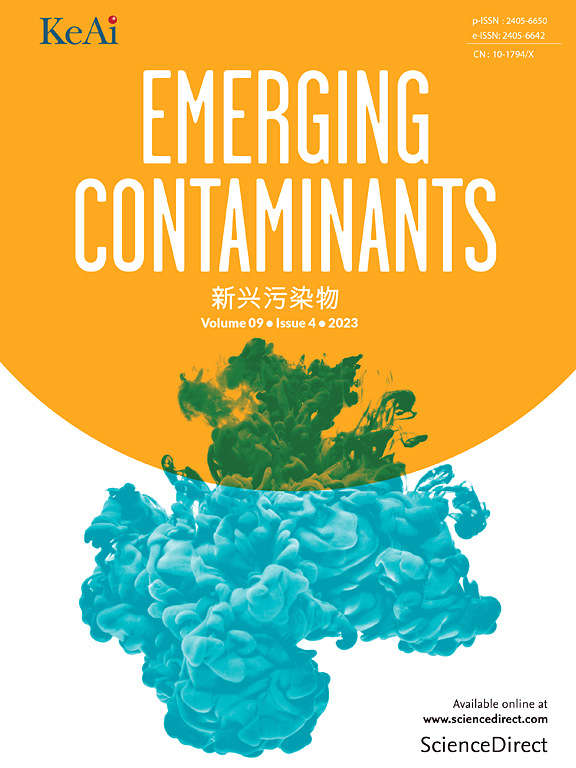Understanding the impact of summer festival on the dynamic of micropollutant delivery to coastal wastewater treatment plant
IF 6.9
2区 环境科学与生态学
Q1 ENVIRONMENTAL SCIENCES
引用次数: 0
Abstract
Coastal cities often experience a surge in population during summer events, leading to heightened pollution entering wastewater treatment plants (WWTPs). However, the impact of these events on wastewater treatment effectiveness and the levels of hazardous substances passed into coastal ecosystems remain poorly understood. This study investigated wastewater quality and specific micropollutants (estrogens, pharmaceuticals, phthalates (PAEs), polycyclic aromatic hydrocarbons) both before and after treatment at WWTP during the summer festival at the south-eastern Baltic coastal city. The results revealed that influent flow, nutrient and pollutant loads, except for pharmaceuticals, increased during the festival. Notably, the load of specific organic pollutants (dissolved organic carbon, estrogen, and PAEs) increased by ∼50 %, which is more than three times the increase in influent flow. Despite this, the treatment process achieved high retention rates between 87 % and 100 %. Nevertheless, the overall effectiveness of the treatment process, the estrogen level in discharged effluents into the sea exceeded the environmental quality standard limits 7–12 fold. Pharmaceuticals and PAEs contributed most to the micropollutant load (25 g day−1 and 34 g day−1, respectively) discharged into the Baltic Sea during the festival. These findings provide novel insights into how temporal gatherings can increase pollution levels in the coastal areas of the Baltic region and highlight the potential for this pollution to be inadequately retained in treatment facilities, posing risks to the marine environment.
了解夏季节日对沿海污水处理厂微污染物输送动态的影响
沿海城市在夏季活动期间经常经历人口激增,导致污水处理厂(WWTPs)的污染加剧。然而,这些事件对废水处理效果和进入沿海生态系统的有害物质水平的影响仍然知之甚少。本研究调查了波罗的海东南部沿海城市夏季节日期间污水处理厂处理前后的废水质量和特定微污染物(雌激素、药物、邻苯二甲酸酯(PAEs)、多环芳烃)。结果显示,除药品外,进水流量、营养物和污染物负荷均有所增加。特别是,特定有机污染物(溶解有机碳、雌激素和PAEs)的负荷增加了~ 50%,是流入流量增加的3倍以上。尽管如此,处理过程仍然实现了87%到100%之间的高保留率。尽管如此,从处理过程的总体效果来看,入海排放物中的雌激素水平超出环境质量标准限值的7-12倍。在节日期间,向波罗的海排放的微污染物负荷中,药品和PAEs的贡献最大(分别为25 g和34 g day - 1)。这些发现为短期聚集如何增加波罗的海地区沿海地区的污染水平提供了新的见解,并强调了这种污染在处理设施中得不到充分保留的可能性,从而对海洋环境构成风险。
本文章由计算机程序翻译,如有差异,请以英文原文为准。
求助全文
约1分钟内获得全文
求助全文
来源期刊

Emerging Contaminants
Medicine-Public Health, Environmental and Occupational Health
CiteScore
10.00
自引率
6.70%
发文量
35
审稿时长
44 days
期刊介绍:
Emerging Contaminants is an outlet for world-leading research addressing problems associated with environmental contamination caused by emerging contaminants and their solutions. Emerging contaminants are defined as chemicals that are not currently (or have been only recently) regulated and about which there exist concerns regarding their impact on human or ecological health. Examples of emerging contaminants include disinfection by-products, pharmaceutical and personal care products, persistent organic chemicals, and mercury etc. as well as their degradation products. We encourage papers addressing science that facilitates greater understanding of the nature, extent, and impacts of the presence of emerging contaminants in the environment; technology that exploits original principles to reduce and control their environmental presence; as well as the development, implementation and efficacy of national and international policies to protect human health and the environment from emerging contaminants.
 求助内容:
求助内容: 应助结果提醒方式:
应助结果提醒方式:


